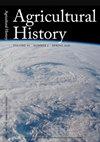野生生长:野生动物管理作为农业科学在美国森林和田野的愿景
IF 0.5
3区 哲学
Q1 HISTORY
引用次数: 0
摘要
面对野生动物数量的减少和新的监管制度,一些美国农民在20世纪初转向了野味养殖。私人支持者和政府机构将野味养殖视为市场狩猎的替代品,并将其视为一个新的农业边界,这可能会进一步模糊野生和栽培自然之间的界限。农场和机构基础设施围绕白尾鹿和环颈野鸡等物种发展,但在两次世界大战结束时逐渐消失。狩猎农业的失败最终源于文化、法律和制度方面的挑战,是二战后农业和野生动物科学彻底分离的缩影。本文章由计算机程序翻译,如有差异,请以英文原文为准。
Growing Wild: Visions of Wildlife Management as Agricultural Science in American Forests and Fields
Faced with dwindling wildlife populations and new regulatory regimes, some American farmers turned to game farming in the early twentieth century. Private boosters and government agencies envisioned game farming as a replacement for market hunting and as a new agricultural frontier, one that might further blur the boundaries between wild and cultivated nature. Farm and institutional infrastructures developed around such species as white-tailed deer and ring-necked pheasants, only to fade by the end of the interwar period. Game farming's lack of success ultimately stemmed from cultural, legal, and institutional challenges and epitomized the thoroughgoing separation of agricultural and wildlife sciences that firmed after World War II.
求助全文
通过发布文献求助,成功后即可免费获取论文全文。
去求助
来源期刊

Agricultural History
农林科学-科学史与科学哲学
CiteScore
0.70
自引率
16.70%
发文量
58
审稿时长
>36 weeks
期刊介绍:
Agricultural History is the journal of record in the field. As such, it publishes articles on all aspects of the history of agriculture and rural life with no geographical or temporal limits. The editors are particularly interested in articles that address a novel subject, demonstrate considerable primary and secondary research, display an original interpretation, and are of general interest to Society members and other Agricultural History readers.
 求助内容:
求助内容: 应助结果提醒方式:
应助结果提醒方式:


